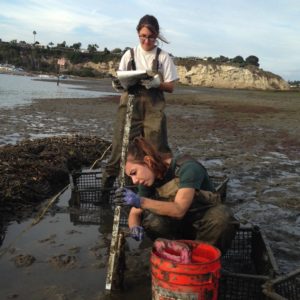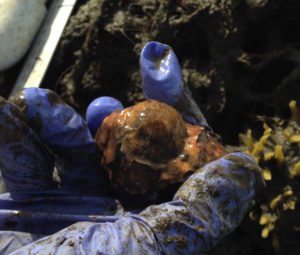
Graduate student Victoria Wood (CSUF) and grad student Kaylee Griffith (SDSU) examine the sediment characteristics six months after oyster restoration
In April 2017, we built restored oyster beds in the wee hours of the morning at low tide in Upper Newport Bay. More than 150 volunteers hauled shells and sewed bags as a part of our Living Shorelines project. Only six months later, their efforts may already be paying off.
Dr. Danielle Zacherl from California State University, Fullerton led a team of graduate students and Orange County Coastkeeper staff and volunteers over four days in early November to sample each of the restored sites to examine recruitment of the native Olympia oysters.
We are also tracking substrate characteristics and noting other species we see on the beds to track what the habitat looks like pre-restoration and post-restoration.
Once completed, this project may provide the following benefits to our waters in Newport Bay:
- Improve water quality by enhancing water filtration
- Provide shallow water habitat for diverse assemblages of animals and plants
- Absorb wave energy and protect the shallow sub-tidal zone
- Return habitat connectivity between terrestrial and subtidal communities

A native Olympia oyster we found in our six-month surveys
We’re encouraged that we are already seeing recruitment of the native Olympia oyster and the results look promising. Stay tuned for more updates, and click here to learn more about Living Shorelines.
To support our work to restore the health of Newport Bay, donate today.






